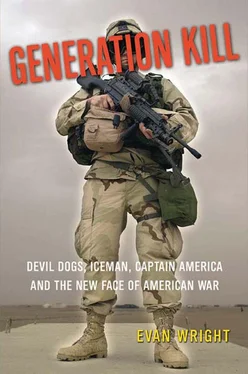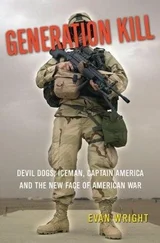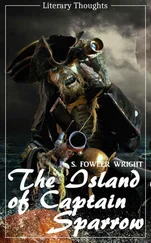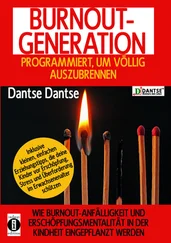At the small-unit level, everyone’s survival boils down to simple human observation. Each Marine in the vehicle is charged with watching a specific sector. To my left, Trombley keeps his SAW machine gun trained out his window. In front of me, Colbert rides leaning into the scope of his M-4 pointed out the passenger window on the right. The Humvees are vulnerable to small arms—AK rifles, RPGs and light machine guns from up to about 600 meters distant, and heavier weapons beyond this range. With each vehicle’s main gun—the Mark-19 grenade launcher or the .50-cal machine gun—accurate to about 1,000 meters, the goal is to identify and destroy any hostile threats before they come within range of the Humvee.
The Marines chatter constantly, calling out everything they see in the surrounding desert—a pipe 300 meters off that could be the barrel of a gun, a shepherd in the distance whose staff could be an AK—while passing binoculars back and forth, and trading information with the other Humvee teams over the radio.
Berms are the dominant feature of Iraq, whether here in the southern desert or in the greener farmlands north of the Euphrates. Berms are man-made piles of sand or earth, ranging in height from a couple of meters to a couple of stories. They are built on the sides of the dry canals, which are scratched throughout the desert. They are built as walls, to contain pastures, to demarcate grazing lands, as windbreaks or as military fortifications. They go in all directions. People have been digging berms here pretty much continually for the past 5,000 years.
The newest berms, which seem to have been excavated in the past few months, hide deep bulldozed pits called revetments, intended to conceal tanks. Every few hundred meters along the berms in some stretches of the desert there are two-meter-high conical towers capped with sandbags, to serve as machine-gun nests. All fortifications appear to have been abandoned.
Colbert’s team passes through them warily. Small groups of hostile forces could be concealed anywhere. In addition, Fick keeps passing down reports he’s receiving from higher-ups in the battalion—rumors of stray Iraqi tank units allegedly operating somewhere in the desert. But no one sees any signs of tanks or hostile forces.
Instead, the Marines begin having their first up-close encounters with Iraqis—small groups of shepherds and women in black robes outside square mud huts. A woman with something in her hands pops out from behind one of the huts a hundred meters back from the trail we’re on.
Colbert shouts up to Garza on the main gun. “Garza! Woman in black. What’s she doing?”
The Mark-19 fills the Humvee with a clattering sound as Garza swivels the gun toward the woman. “She’s carrying a bag in her hands,” he shouts from the turret. “No weapons.”
A moment later Garza shouts. “Hey!”
Colbert tenses on his M-4, pressing his eye against the scope. “Talk to me, Garza. What is it?”
“I just waved at an Iraqi and he waved back at me. That was cool.”
“Good, Garza,” Colbert says. “Keep making friends. As long they’re not doing anything where we have to shoot them.”
“Hey, it’s ten in the morning!” says Person, yelling at two farmers dressed in robes in the distance. “Don’t you think you ought to change out of your pajamas?”
BY LATE AFTERNOON First Recon has pushed fifty kilometers into Iraq, becoming the northernmost Marine unit in the country. Now no one has slept for thirty-six hours. It’s in the upper eighties outside, and cramped in the Humvee in plastic-lined MOPPs and rubber boots, everyone’s face drips sweat. Between calling out potential targets, Colbert and Person stay awake by screeching pop songs—Avril Lavigne’s “I’m with You” and “Skater Boy”—deliberately massacring them at the tops of their lungs.
Marines supplement their diets of caffeine, dip and ephedra (technically banned in the Corps, but liberally consumed) with candy and junk food. Military rations, called “meals ready to eat” (MREs), come in brown plastic bags about three quarters of the size of a phone book. Each contains a main meal like spaghetti, stew or “chunked and formed” meat patties in a foil pouch. You heat these pouches by shoving them inside a plastic bag with chemicals in it. When you add water, the chemicals immediately boil, emitting noxious and (according to warnings on the package) explosive fumes. The main entrées are prepared through a mysterious desiccation process. Even though your meat patty might be swimming in juices, when you bite into it, it’s dry and crumbly and brings to mind chewing on a kitchen sponge. In flush times like now, at the start of the invasion, when every Marine is rationed three MREs a day, most push aside the main meals and eat the extras. In addition to entrées, MREs are loaded with junk food—pound cakes, brownies, “Toaster Oven Pastries” (identical to Pop-Tarts), cookies, Skittles, M&M’s, Tootsie Rolls, Charms hard candies, Combos cheese-filled pretzels, and powdered grape-drink mix and cocoa powder, which Marines eat straight out of the packages, like the instant coffee.
The process of tearing through an MRE and picking out the goodies is called “ratfucking.” Colbert’s team maintains a ratfuck bag in their Humvee for all the discarded MRE entrées, saving them for a rainy day.
Though at times throughout the advance north, Colbert’s vehicle goes on point for the entire battalion, placing its occupants at the very tip of the Coalition invasion, as the heat and fatigue delirium sets in, the undertaking sometimes feels like a family road trip. Colbert is the stern father figure. Person is like the mom, the communicator, trying to anticipate his needs, keeping spirits up with his cheerful banter. Garza and Trombley are the children, happily munching candy, eager to please their dad.
As team leader, Colbert controls every aspect of his men’s lives, down to their bodily functions.
“Trombley,” Colbert shouts, leaning over his rifle, watching his sector. “Are you drinking water?”
“Yes, Sergeant.”
“Are you pissing?”
“At our last halt, Sergeant.”
“Was it clear?”
“Yes, Sergeant.”
“Good.”
ACOUPLE OF HOURS before sundown, battalion radios explode with chatter. Several teams in our convoy spot a pair of new-looking white SUVs traveling along an adjacent trail at a high rate of speed. The trucks are marked with red circles on the doors and are loaded with clean-shaven young Arab men armed with AK rifles. The Recon Marines request permission to stage a “snatch mission” on the trucks—to go after them, grab the occupants and find out who they are. The request is denied. The vehicles are allowed to pass. The Marines are infuriated. Later, they’ll find out the armed men who ride in civilian trucks, especially those with markings on the side, are Fedayeen—paramilitary guerrilla fighters. At this stage in the campaign, top U.S. commanders are concerned only with fighting regular Iraqi forces, defeating them en masse as they did in the first Gulf War. It will take a few days before American commanders realize their most dangerous opponents are the Fedayeen, who are gearing up to fight them in a guerrilla war. So for now, the Marines are ordered to simply let these guys pass right by them.
At this point in the day, the Marines in Colbert’s vehicle are pretty much in the dark as to what they’re doing. They’ve been pushing north for hours, but they’re not heading in the right direction to begin the mission they have all trained for: seizing the bridge on the Euphrates.
Colbert tries to tune in the BBC during a brief halt. The BBC will emerge as the best source of information on the invasion in which the Marines are participating—even Battalion Commander Lt. Col. Ferrando relies on it. But during this stop, reception is too spotty to pick up any news. “I have no intel, no big picture,” Colbert tells his team.
Читать дальше












